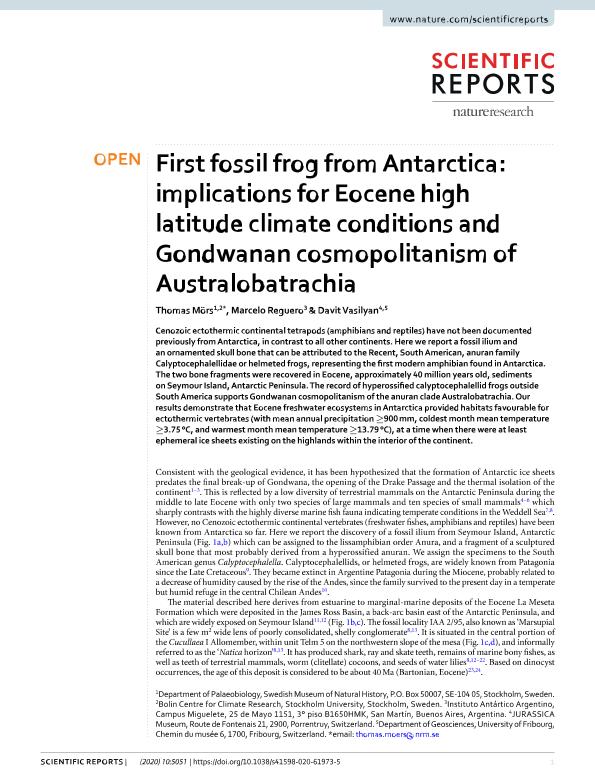Artículo
First fossil frog from Antarctica: Implications for Eocene high latitude climate conditions and Gondwanan cosmopolitanism of Australobatrachia
Fecha de publicación:
04/2020
Editorial:
Nature
Revista:
Scientific Reports
ISSN:
2045-2322
Idioma:
Inglés
Tipo de recurso:
Artículo publicado
Clasificación temática:
Resumen
Cenozoic ectothermic continental tetrapods (amphibians and reptiles) have not been documented previously from Antarctica, in contrast to all other continents. Here we report a fossil ilium and an ornamented skull bone that can be attributed to the Recent, South American, anuran family Calyptocephalellidae or helmeted frogs, representing the first modern amphibian found in Antarctica. The two bone fragments were recovered in Eocene, approximately 40 million years old, sediments on Seymour Island, Antarctic Peninsula. The record of hyperossified calyptocephalellid frogs outside South America supports Gondwanan cosmopolitanism of the anuran clade Australobatrachia. Our results demonstrate that Eocene freshwater ecosystems in Antarctica provided habitats favourable for ectothermic vertebrates (with mean annual precipitation ≥900 mm, coldest month mean temperature ≥3.75 °C, and warmest month mean temperature ≥13.79 °C), at a time when there were at least ephemeral ice sheets existing on the highlands within the interior of the continent.
Palabras clave:
Anura
,
Calyptocephalellidae
,
Eocene
,
Antarctica
Archivos asociados
Licencia
Identificadores
Colecciones
Articulos(CCT - LA PLATA)
Articulos de CTRO.CIENTIFICO TECNOL.CONICET - LA PLATA
Articulos de CTRO.CIENTIFICO TECNOL.CONICET - LA PLATA
Citación
Mörs, Thomas; Reguero, Marcelo Alfredo; Vasilyan, Davit; First fossil frog from Antarctica: Implications for Eocene high latitude climate conditions and Gondwanan cosmopolitanism of Australobatrachia; Nature; Scientific Reports; 10; 1; 4-2020; 1-11
Compartir
Altmétricas




